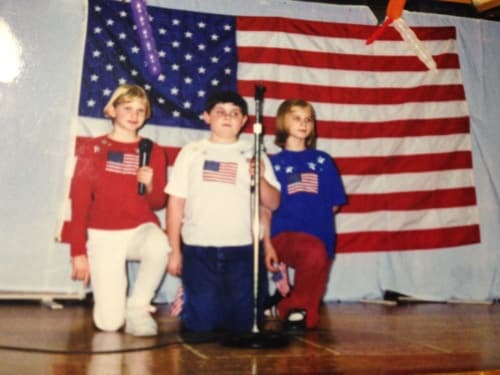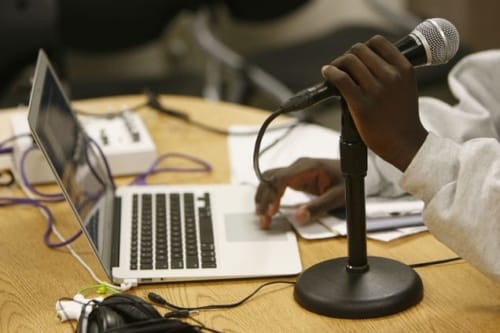The Power of a Podcast Produced by Imprisoned Youth
When I was in 4th grade I sang “God Bless America” at a talent show in my one-hall elementary school in rural New York. The old memory arose for me while listening to the song in accompaniment of a colorful firework display this past week for 4th of July.
 As I sang along once more to the familiar tune, a certain uneasiness swelled in my chest as the second stanza lyrics escaped my lips:
As I sang along once more to the familiar tune, a certain uneasiness swelled in my chest as the second stanza lyrics escaped my lips:
I’d thank my lucky stars
To be living here today
Cause the flag still stands for freedom
And they can’t take that away
Is freedom as guaranteed as I was originally taught? What does freedom mean to different individuals living in this country, particularly youth?
According to the Prison Policy Initiative, 34,000 youth are incarcerated in the United States. In addition to this count, 4,500 are locked up in adult prisons or jails and nearly 20,000 are housed in juvenile residential facilities excluded from official incarceration statistics.
While grade school students may study the Constitution and the Bill of Rights to pass an exam or complete a project, many youth behind bars learn about the laws of our land in a more confronting way. The knowledge they gain from the school of hard knocks is silenced along with their hopes and fears through the barriers built by our $182 billion prison industry.
 The youth media organization Spy Hop is working to make such walls more permeable through their Sending Messages podcast that has been broadcasting a teen-produced radio show from secure care youth corrections facilities throughout Salt Lake City, UT since 2010.
The youth media organization Spy Hop is working to make such walls more permeable through their Sending Messages podcast that has been broadcasting a teen-produced radio show from secure care youth corrections facilities throughout Salt Lake City, UT since 2010.
I recently found out about the initiative through moderating a NAMLE conference session in which two of Spy Hop’s staff spoke about the program’s purpose, impact and their experiences facilitating it.
Adam Sherlock, the Community Programs Manager, described how the podcasting process offers participants opportunities for reflection along with new ways of understanding the challenges they have faced, the decisions they have made and their current place in the world.
Gabriella Huggins, the Community Partnerships Mentor explains, “Often, these young people have histories of being shuffled through toxic systems that leave them invisible and silenced, and in turn, make them feel as though they have no agency.”
Adam adds. “For many of these young people, just knowing that there is an audience who are listening and want to hear their stories can be a powerful message.”
“We believe this platform can contribute to communicating realities instead of reinforcing harmful stereotypes,” Gabriella states. “We hope the audiences we reach are influenced to think with nuance about the students who share their stories, and act in a way that meaningfully addresses the larger issues landing these kids in the system.”
Peaked with curiosity from their powerful presentation, I skimmed through the online recorded archives and discovered Episode 38: Freedom. The half-hour show was broken up into chapters that took various creative forms linked together by a host.
Following an interview of an 18-year old father who acknowledged too much freedom in his life led to losing all privilege, a youth-produced rap song came on with the following chorus:
Freedom, someone tell me what it’s all about.
Haven’t seen it in years, even when I’m on the out.
Whether it’s the drugs and the laws or if I’m doing my time
freedom’s a concept that’s escaped my mind.
The young father’s voice rang in my head once more. “Freedom is going outside when you want,” he stated matter-of-factly. “Freedom is being with family,” which he didn’t have around growing up and acknowledged he needed to fix moving forward.
While the American flag waves high this time of year representing freedom to those of us barbecuing with loved ones in backyards with no gates, the concept is foreign to others locked up and lonely, sharing their thoughts through sporadic airwaves.
Author
 Kelsey Greene, M.Ed, is a producer, educator and scholar who combines her creative talents and academic knowledge to advance instructional practices, learning experiences and organizations’ media outreach.
Kelsey Greene, M.Ed, is a producer, educator and scholar who combines her creative talents and academic knowledge to advance instructional practices, learning experiences and organizations’ media outreach.
She is currently the Director of Strategic Initiatives for MindRocket Media Group and on the Leadership Council for the National Association of Media Literacy Education. She has developed media literacy curriculum for organizations throughout the country and has taught middle-school students through adult educators in both formal and informal settings in New York, Rhode Island and Illinois.
Follow Kelsey Greene on Twitter
- Huffington Post – It’s Time to End the School-to-Prison Pipeline
- AL.com – Tablets for inmates? Only if it’s first of many steps in much-needed prison reform
- The Atlantic – The Lifelong Learning of Lifelong Inmates


